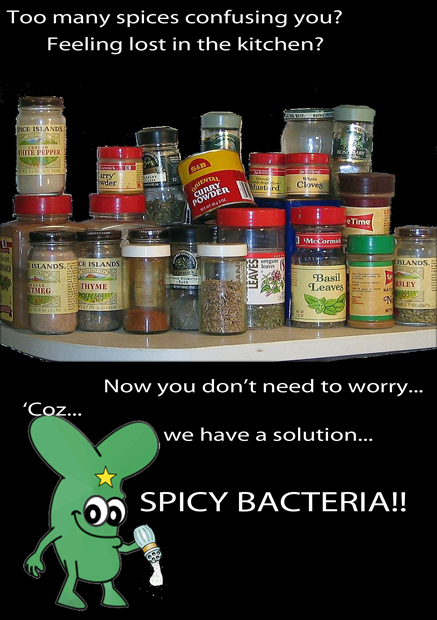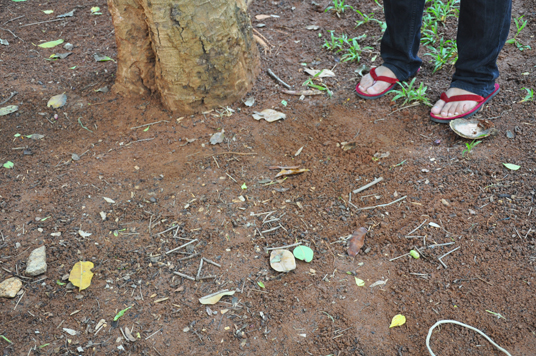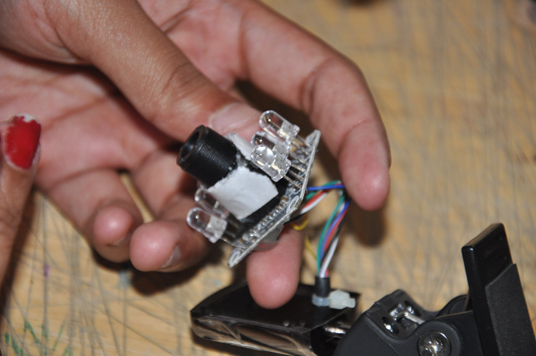Difference between revisions of "Prakrithy Pradeep"
| Line 61: | Line 61: | ||
[[File:DNA.jpg]] | [[File:DNA.jpg]] | ||
| + | |||
| + | |||
| + | I chose to bury my DNA in the ground itself, at the base of a tree. I had two reasons for this. One, we are a part of nature, and that is where we end as well. So, why should my DNA be any different from any other part of me? Also, my name means nature, in most of the Indian languages (including Sanskrit). So i felt back to nature would be the most fittng way for my DNA to go. | ||
| + | |||
| + | I dug a small hole in the ground and poured the solution containing my DNA into it. I covered up the hole with soil, and marked the spot with a broken coconut shell, some twigs and leaves I found around. The markings were chosen in order to ensure that my DNA's "grave" would stand out. And i realised it wouldn't stand out especially not in the grassy, plant filled yard of our college. | ||
| + | |||
| + | Here's a photo of the burial site. | ||
| + | |||
| + | |||
| + | [[File:Burial.jpg]] | ||
Revision as of 20:39, 30 May 2011
24th May 2011 - A New Beginning
First day of IGEM...what do I say? I was disoriented at first...very disoriented. I mean a science classroom in an art college. I agree I might be stereotyping. I didn’t really know what to expect. Here I was, an art and design student doing a synthetic biology project.
Having studied biology earlier, especially genetics, (not in depth, but whatever CBSE had deemed necessary for their students to know) I remembered bits and pieces of our classes, in that dark classroom of my school. It surprised me that I’d begun this venture with a seemingly clean slate, surprised that I had not retained much of what I had studied earlier.
That’s where we began. A discussion on what we thought synthetic biology was. Awkward silences and many pauses. The ice had yet to be broken. New faces weren’t the issue, the foreign nature of the subject of our discussion was. So we plodded on. About genes, DNA, traits. Life. What form of life could be without form? A formless form of life? God? Plasma? Viruses? That opened us up. We discussed ideas, and concepts. And got our very first assignment! To think of the most insane form of life we could think up. Then was time for research. I researched synthetic biology, gene expression, DNA, genes, nucleic acids, formation of DNA, and a whole host of other random terms that hit me at that time that I don’t seem to have retained anywhere my head (Note to self: Must remember to go check up all those again!!). A tutorial on scientific jargon later, we were dismissed for the day.
Totally blank, and honestly, a bit lost, to thinking and innovating. All in a day's work, I guess. But I do know this for sure, I am definitely looking forward to where we will be going from here.
An Idea
Spices like chillies & pepper feel "hot" beacuse they contain certain chemicals like capsaicin and piperine. Our body (mainly our mouth) feels a sensation of burning pain, as a result of these chemicals. Our sensory neurons contain a functional cDNA encoding for a capsaicin receptor. The receptor is a non-selective cation channel that is also activated by increases in temperature. Similarly, other spices will all have acting chemicals, mostly organic. Each spice will also have corresponding receptors, or mechanisms, to induce responses.
Most of the spices and condiments used are plant parts. This implies that they do contain cells (living or dead. Cells contain DNA, which would be responsible for the production of the chemicals responsible for the flavours of the spices. We would be able to identify the exact DNA sequences that code for the necessary chemicals by DNA sequencing. Once the sequences are identified, they can be introduced into the DNA of a suitable, safe bacteria.
This bacteria would produce the different chemicals (for the spices) in certain fixed quantities when introduced into the food. This would reduce the chances of dishes getting "spoilt" due to the usage of incorrect mixtures and quantities of spices.
This idea is what I call the "spicy bacteria".
Day 2 – 25th May 2011
After discussing each of our ideas for new life forms, we researched DNA extraction and BioBricks. After breaking for lunch, we extracted our very own DNA, and buried it in a way that we chose!!!
In a few very simple steps, I’ll show you how to extract your DNA.
STEP 1: Gargle your mouth with salt water.
STEP 2: Empty the contents of your mouth into a test-tube.
STEP 3: Along the sides of the test-tube, pour liquid detergent.
STEP 4: After allowing the detergent to settle at the bottom, pour some chemist’s alcohol along the sides of the test-tube.
STEP 5: VOILA! You will observe a white cloud rising through the alcohol. That is your DNA.
Here's a photo of my DNA...
I chose to bury my DNA in the ground itself, at the base of a tree. I had two reasons for this. One, we are a part of nature, and that is where we end as well. So, why should my DNA be any different from any other part of me? Also, my name means nature, in most of the Indian languages (including Sanskrit). So i felt back to nature would be the most fittng way for my DNA to go.
I dug a small hole in the ground and poured the solution containing my DNA into it. I covered up the hole with soil, and marked the spot with a broken coconut shell, some twigs and leaves I found around. The markings were chosen in order to ensure that my DNA's "grave" would stand out. And i realised it wouldn't stand out especially not in the grassy, plant filled yard of our college.
Here's a photo of the burial site.
Day 3 – 26th May 2011
Today, we began with research into the equipment necessary for laboratories – a basic science one, and a microbiology one too. We considered the equipment we’d need for our very own microbiology lab. And we’re going to be building most of these. This task has been given out to certain groups of people. The group I am a part of is going to be making a desiccator and a laminar airflow cabinet. Our group discussed the equipment we’d chosen, studied its structure and normal construction. We also had to look at low-cost, high efficiency substitutes and alternate methods of construction for the very same equipment. We discussed all of that without coming to any concrete conclusions.
After lunch, our senior, Aaron, taught us how to make a microscope out of a webcam. All we neede to do was open the webcam up, and reverse the lens. Fantastic, isn't it? We thought so too. But the only issue with this microscope was it's stability. The stability of our microscope would depend on the hand of the holder. From this issues, rose our next challenge. To design a stable, safe structure with adeqaute lighting, for "finishing" our microscope.



